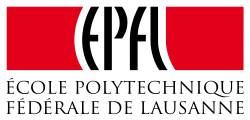École Polytechnique Fédérale de Lausanne
| École polytechnique fédérale de Lausanne | |
 |
|
| Type | Public |
|---|---|
| Established | 1853 |
| Budget | 896 million CHF |
| President | Martin Vetterli |
| Undergraduates | 5,205 (2015) |
| Postgraduates | 4,919 (2015) |
| Location |
Écublens (near Lausanne), Vaud, Switzerland 46°31′13″N 6°33′56″E / 46.52028°N 6.56556°ECoordinates: 46°31′13″N 6°33′56″E / 46.52028°N 6.56556°E |
| Campus | Urban |
| Nationalities | 125+ |
| Affiliations | AUF, EUA, Eurotech, CLUSTER, and TIME |
| Website | www |
| University Rankings 2015 | |
|---|---|
| Engineering & Technology Rankings | |
| Global | |
| Times | 12 |
| QS | 17 |
| ARWU | 14 |
| Europe | |
| Times | 5 |
| QS | 5 |
| ARWU | 3 |
The École polytechnique fédérale de Lausanne (EPFL; English: Swiss Federal Institute of Technology in Lausanne) is a research institute/university in Lausanne, Switzerland, that specialises in physical sciences and engineering. The Swiss Federal Institute of Technology complex has three main world-rank missions: education, research and technology transfer at the highest international level.
EPFL is widely regarded as one of the world leading universities. The QS World University Rankings ranks EPFL 14th in the world across all fields in their 2015/2016 ranking, while Times Higher Education World University Rankings ranks EPFL as the worlds 12th best school for Engineering.
EPFL is located in the French-speaking part of Switzerland; the sister institution in the German-speaking part of Switzerland is the Swiss Federal Institute of Technology in Zurich (ETH Zurich). Associated with several specialised research institutes, the two universities form the Swiss Federal Institutes of Technology Domain (ETH Domain), which is directly dependent on the Federal Department of Economic Affairs, Education and Research. In connection with research and teaching activities, EPFL operates a nuclear reactor CROCUS, a Tokamak Fusion reactor, a Blue Gene/Q Supercomputer and P3 bio-hazard facilities.
The roots of modern-day EPFL can be traced back to the foundation of a private school under the name École spéciale de Lausanne in 1853 at the initiative of Lois Rivier, a graduate of the École Centrale Paris and John Gay, the then professor and rector of the Académie de Lausanne. At its inception it had only 11 students and the offices was located at Rue du Valentin in Lausanne. In 1869, it became the technical department of the public Académie de Lausanne. When the Académie was reorganised and acquired the status of a university in 1890, the technical faculty changed its name to École d'ingénieurs de l'Université de Lausanne. In 1946, it was renamed the École polytechnique de l'Université de Lausanne (EPUL). In 1969, the EPUL was separated from the rest of the University of Lausanne and became a federal institute under its current name. EPFL, like ETH Zurich, is thus directly controlled by the Swiss federal government. In contrast, all other universities in Switzerland are controlled by their respective cantonal governments. Following the nomination of Patrick Aebischer as president in 2000, EPFL has started to develop into the field of life sciences. It absorbed the Swiss Institute for Experimental Cancer Research (ISREC) in 2008.
...
Wikipedia
